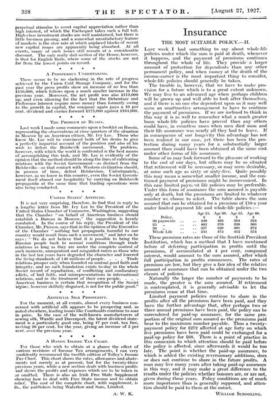Insurance
THE MOST SUITABLE POLICY.—II.
LAST week I had something to say about whole-life policies under which the sum is paid at death, whenever it happens, and the payment of premiums continues throughout the whole -of life. They provide -alarger amount of protection for dependents than any other permanent policy, and when money at the death of the. income-earner- is the most important thing to Consider, whole-life policies should generally be taken.
The trouble is, however, that we have to make pro-' vision for a future which is to a great extent unknown.' We may live to an advanced age when perhaps children. will be grown up and well able to look after themselves,. and if there is no one else dependent upon us it may well seem an unattractive arrangement to have to continue -the payment of premiums. If we are inclined to think in this way it is as well to remember what a much greater boon whole-life policies have proved than any others could have, in countless cases when men died soon and their life assurance was nearly all they had to leave. If in consequence of our longevity this advantage has not been realized in our case, yet there has been the pro- tection during many years for a substantially larger amount than could' have been obtained at the same cost under other forms of life assurance.
Some of us may look forward to the pleasure of working to the end of our days, but others may be so situated that retirement will be necessary, or may seem desirable, at some such age as sixty or sixty-five. Quite possibly this may mean a somewhat smaller income, and-the con- tinued payment of premiums might be inconvenient. In this case limited paym:mt life policies may be.preferable. Under this form of assurance the sum assured is payable only at death, but the premiums are limited to whatever number we choose to select. The table shows the sum , assured that can be obtained for a premium of 110 a year under limited payment life and whole-life policies :—
Policy. Age 25. Age 30. Age 35. £ £ Age 40.
30 payments 440 402 364 324 25 402 370 338 303 20 „ 357 329 301 272 Whole Life .. 534 473 412- 354
These premium rates are those of the Scottish Provident Institution, which has a method that I have mentioned before of deferring participation in profits until the premiums, if accumulated at 4 per cent. compound interest, would amount to the sum assured, after which full participation in profits commences. The rates of premium are low,. but they give a fair idea of the relative amount of assurance that can be obtained under the two classes of policies.
Naturally the larger the number of payments to be made, the greater is the sum assured. If retirement is contemplated, it is generally advisable to let the premiums cease at that time. Limited payment policies continue to share in the profits after all the premiums have been paid, and they have the further advantage that, after perhaps two or three annual premiums have been paid, the policy can be surrendered for paid-up assurance, for the same pro- portion of the original sum assured as the premiums paid bear to the maximum number payable. Thus a twenty- payment policy for £272 affected at age forty on which five premiums have been paid could be exchanged for a paid-up policy for £68. There is a point of practice in this connexion to which attention should be paid before the policy is affected, since afterwards it would be too late. The point is whether the paid-up assurance, to which is added the existing reversionary additions, does or does not continue to share in the future profits. A man may live many years after taking paid-up assurance in this way, and it may make a great difference to the results under the policies whether bonuses are, or are not, given during those years. Policy conditions are of much more importance than is generally supposed, and atten- tion should be paid to them at the outset.
WILLIAM SCHOOLING.


































 Previous page
Previous page